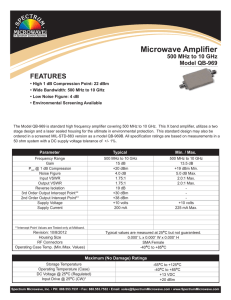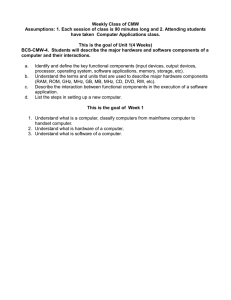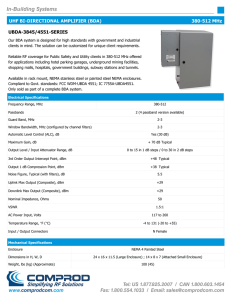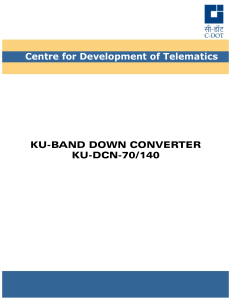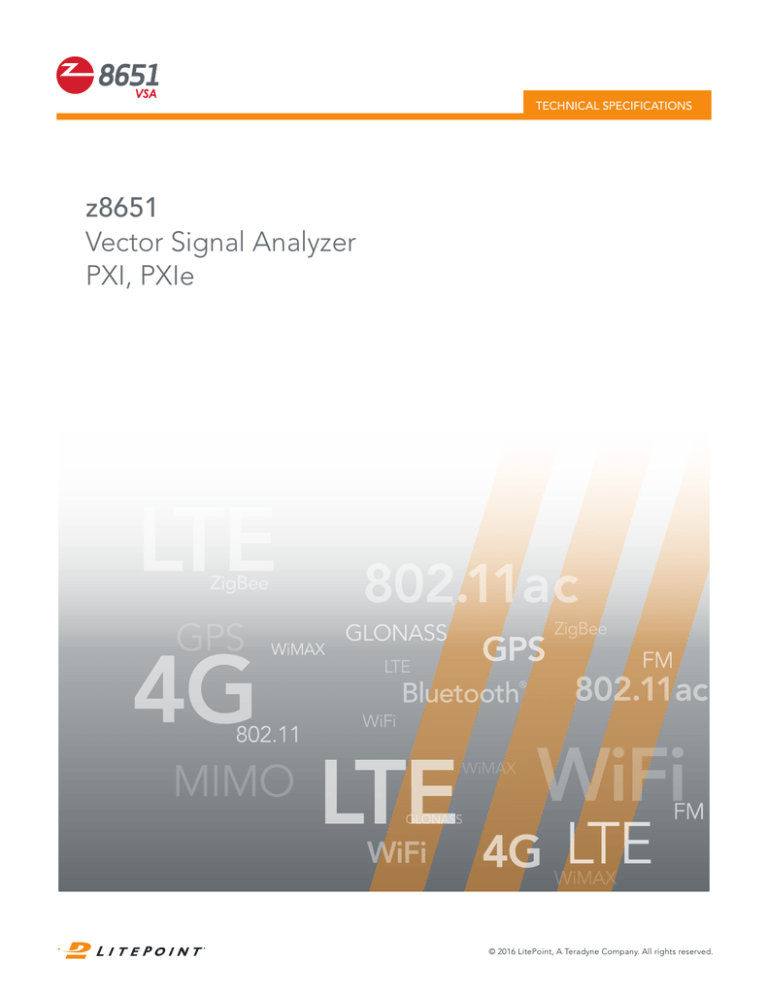
TECHNICAL SPECIFICATIONS
z8651
Vector Signal Analyzer
PXI, PXIe
© 2016 LitePoint, A Teradyne Company. All rights reserved.
Port Descriptions
Front Panel
Label
Type
Description
I +,-
SMA
Differential baseband I input
Q +,-
SMA
Differential baseband Q input
RF IN
SMA
RF input signal
LO IN
SMA
Local Oscillator input
EXT IN
SMB
External input for trigger or reference
EXT OUT
SMB
External output for trigger, reference or event
Vector Signal Analyzer 2
RF Input
RF Input Channel
Specification
Value
Channel
Quantity 1
Input Impedance
50 Ω
≤ ±1% accuracy
Input VSWR (Attenuator #1 On)1**
500 MHz to 4 GHz
4 GHz to 5.4 GHz
5.4 GHz to 6 GHz
Input VSWR (Attenuator #1 Off)**
500 MHz to 4 GHz
4 GHz to 5.4 GHz
5.4 GHz to 6 GHz
≤ 1.2:1 (-20.8 dB RL)
≤ 1.4:1 (-15.5 dB RL)
≤ 2.0:1 (-9.5 dB RL)
≤ 1.4:1 (-15.5 dB RL)
≤ 1.6:1 (-12.7 dB RL)
≤ 2.2:1 (-8.5 dB RL)
Attenuator & Preamplifier Stages2
RF Attenuator #1 (electronic)
RF Preamplifier (electronic)
RF Attenuator #2 (electronic)
IF Attenuator #3 (electronic)
IF Amplifier (mechanical)
0 – 31.5 dB attenuation, 0.5 dB steps
0 or 20 dB gain
0 – 31.5 dB attenuation, 0.5 dB steps
0 – 31.5 dB attenuation, 0.5 dB steps
0 – 30 dB gain, 10 dB steps
Typical Attenuator #1
& Preamp Configuration3
Attenuator #1 On, Preamp Bypassed
Attenuator #1 On, Preamp Enabled
Attenuator #1 Off, Preamp Enabled
Reference Level:
≥ 0 dBm
-20 dBm to -0.5 dBm
-50 dBm to -20.5 dBm
Connectors
SMA
See Figure 1 for a plot of RF input return loss with Attenuator #1 On (data for ten instruments).
See Figure 2 for a simplified block diagram of RF path showing programmable attenuator and preamplifier stages.
3
The automatic attenuation mode will optimize the programmable amplifier and attenuator settings for balanced
noise and distortion performance using the frequency-dependent level calibration data.
1
2
Vector Signal Analyzer 3
Figure 1: Typical RF Input Return Loss (RL) with Attenuator #1 On
ATT1
ATT3
ATT2
RF IN
IF AMP
ADC
LPF
0 to 31.5 dB
0 to 31.5 dB
PREAMP
20 dB
0 to 31.5 dB
0 to 30 dB
10 dB Steps
PLL
LO IN
Figure 2: Simplified Block Diagram Showing Attenuator and Preamplifier Stages
Vector Signal Analyzer 4
RF Input Reference Level
Specification
Value
Absolute Maximum Input (no damage)
Preamplifier Bypassed
Preamplifier Enabled
+30 dBm
+10 dBm
Reference Level Range
(set for average power)4
-50 dBm to +20 dBm
0.5 dB steps
Reference Level Accuracy
(at 25 °C ambient)
≤ ±0.5 dB
≤ ±0.1 dB typical
Reference Level Temperature Drift**
-0.03 dB/°C
Reference Level Switching Speed
≤ 1 ms, any level change
RF Input Frequency
Specification
Value
Input Frequency Range
250 MHz to 6 GHz
Input Frequency Resolution
1 Hz
Input Frequency Switching Speed
≤ 1 ms, any frequency change
RF Input Instantaneous IF Bandwidth
Specification
Value
IF Bandwidth (IFBW)
162.5 MHz
81.25 MHz to 100 Hz
1 Hz resolution
Resolution Bandwidth
1 Hz to 3 MHz
0.1 Hz resolution
0.2
IFBW Flatness
≤ ±1 dB
IFBW Phase Linearity
≤ ±2°
RF Input Dynamic Performance
Specification
Value
Spurious-Free Dynamic Range
(excluding harmonics)
≥ 75 dBc
0 dBm Reference Level
Third-Order Intermodulation Distortion
(IMD3)5
≥ 80 dBc
RF Input Harmonics
≤ -40 dBc
ssumes crest factor of +10 dB. Peak Envelope Power (PEP) is 10 dB higher than average power, and the
A
ADC full-scale range provides 10 dB of headroom above the selected Reference Level.
5
See Figures 3 and 4 for plots of the noise and distortion tradeoff versus input power for a fixed Reference
Level setting (with preamplifier bypassed and enabled).
4
Vector Signal Analyzer 5
Displayed Average Noise Level (DANL)
Reference Level
Value
0 dBm
-145 dBm/Hz
-10 dBm
-155 dBm/Hz
-20 dBm
-162 dBm/Hz
-30 dBm
-165 dBm/Hz
-40 dBm
-165 dBm/Hz
-50 dBm
-165 dBm/Hz
Figure 3: Noise and distortion for 0 dBm Reference Level
(preamplifier bypassed)
Figure 4: Noise and distortion for -40 dBm Reference Level
(preamplifier enabled)
Vector Signal Analyzer 6
Phase Noise, Single Sideband, PXIe (Typical)
Offset
1.0 GHz
2.4 GHz
5.8 GHz
1 kHz
-99 dBc/Hz
-93 dBc/Hz
-85 dBc/Hz
10 kHz
-122 dBc/Hz
-115 dBc/Hz
-107 dBc/Hz
100 kHz
-125 dBc/Hz
-118 dBc/Hz
-109 dBc/Hz
1 MHz
-136 dBc/Hz
-133 dBc/Hz
-129 dBc/Hz
Figure 5: Typical Phase Noise (PXIe)
Vector Signal Analyzer 7
Local Oscillator Input
Local Oscillator (LO) Input Channel
Specification
Value
LO Input Channel
Quantity 1
Input Impedance
50 Ω
Connector
SMA
Input Level
0 dBm nominal, ±2 dB
Absolute Maximum Input
+10 dBm
Frequency Range
250 MHz to 6 GHz
Timebase Reference
Specification
Value
Timebase Reference
10 MHz or 100 MHz
Timebase Reference Source
Internal TCXO, External Input,
Backplane CLK10 or CLK100 (PXIe)
Internal TCXO Timebase
±2.5 ppm accuracy
Timebase Output
External Output
Baseband Inputs
I/Q Input Channels
Specification
Value
Channels
Two Differential Input Channels
I+/- and Q+/- (One I/Q)
Input Impedance
Single-ended
Differential
50 Ω
100 Ω
≤ ±1% accuracy
Input VSWR**
DC to 250 MHz
≤ 1.3:1
Input Bias Current**
≤ ±10 μA
Connectors
SMA
Vector Signal Analyzer 8
I/Q Input Voltage
Specification
Value
Absolute Maximum Input (no damage)
Single-ended
-2 V to +5 V (DC + peak AC), CAT I
Input Voltage Ranges
+10 dBm ( 2 Vppd)
0 dBm ( 0.63 Vppd)
-10 dBm ( 0.2 Vppd)
-20 dBm ( 0.063 Vppd)
Input Voltage Range Accuracy (1 MHz)
≤ ±0.05 dB at 25°C ambient
≤ ±0.01 dB drift per °C
Input Offset Adjustment
±1 V
4 μV resolution
Input Offset Accuracy
< ±(2 mV + 0.5% offset) at 25°C
≤ ±200 μV drift per °C
Vector Signal Analyzer 9
I/Q Input Dynamic Performance
Specification
Value
Analog Bandwidth
-3 dB Bandwidth
Stopband Rejection
DC to 300 MHz
≥80 dB at 800 MHz
Spurious-Free Dynamic Range
(excluding harmonics)
≥ 80 dBc at 10 MHz
Harmonic Distortion
≥ 75 dBc at 10 MHz
Intermodulation Distortion
(2 tone, 10.6 MHz & 10.8 MHz)
≥ 80 dBc
Average Noise Density
+10 dBm Range
0 dBm Range
-10 dBm Range
-20 dBm Range
≤ -145 dBm/Hz (-155 dBFS/Hz)
≤ -150 dBm/Hz (-150 dBFS/Hz)
≤ -153 dBm/Hz (-143 dBFS/Hz)
≤ -154 dBm/Hz (-134 dBFS/Hz)
Phase Noise (187.5 MHz, typical)
1 kHz offset frequency
10 kHz offset frequency
100 kHz offset frequency
1 MHz offset frequency
10 MHz offset frequency
-110 dBc/Hz
-130 dBc/Hz
-132 dBc/Hz
-138 dBc/Hz
-140 dBc/Hz
I/Q Channel-to-Channel Match
(DC to 50 MHz, same range settings)
≤ 0.2 dB magnitude
≤ 0.5° phase
I/Q Channel-to-Channel Isolation
DC to 100 MHz
100 MHz to 250 MHz
≥ 90 dB
≥ 80 dB
Vector Signal Analyzer 10
Analog-to-Digital Converter (ADC) & Digital Downconverter (DDC)
6
Specification
Value
ADC Configuration
Simultaneous Sampling Dual ADC
ADC Vertical Resolution
14 Bits
0.0061% of full-scale range
ADC Clock Frequency
400 MS/s simultaneous sampling
ADC Clock Jitter**
≤ 300 fs RMS
I/Q Data Vertical Resolution6
up to 32 bits
16-bit and 32-bit data formats
I/Q Data Rate (flexible data rate with
fractional resampling)
123 S/s to 100 MS/s, 200 MS/s
400 MS/s (DDC Bypass)
1 Hz resolution
2
I/Q Data Memory
512 MiByte total
I/Q Waveform Size (matched I/Q sizes)
up to 128 MiSamples (16-bit data)
up to 64 MiSamples (32-bit data)
I/Q Channel Mode (DDC input feed)
I/Q quadrature input pair
I input only
Q input only
Independent I and Q (real mixing)
I/Q Instantaneous Bandwidth (alias-free)
162.5 MHz
81.25 MHz to 100 Hz
1 Hz resolution
I/Q Resolution Bandwidth (RBW)
1 Hz to 3 MHz
0.1 Hz resolution
I/Q Center Frequency
0 Hz to 1 GHz
1 Hz resolution
DC filtering of quantization noise adds to vertical resolution by 10*log10(OSR),
D
where OSR is the oversampling ratio. For example, DDC filtering from 400 MS/s
to 100 MS/s provides 10*log10(400/100)=6 dB, or 1 bit additional resolution.
Vector Signal Analyzer 11
WLAN Modulation Analysis
IEEE 802.11a/g/n/ac OFDM
Residual EVM, Internal LO (Typical)
Modulation
Bandwidth
RF Input Frequency: 2.4 GHz to 2.5 GHz7
RF Input Reference Level: -30 dBm to +5 dBm
preamble only
preamble, pilot & data
20 MHz
-50 dB (0.32%)
-52 dB (0.25%)
40 MHz
-47 dB (0.45%)
-49 dB (0.35%)
Modulation
Bandwidth
RF Input Frequency: 5 GHz to 6 GHz8
RF Input Reference Level: -30 dBm to +5 dBm
preamble only
preamble, pilot & data
20 MHz
-45 dB (0.56%)
-47 dB (0.45%)
40 MHz
-44 dB (0.63%)
-46 dB (0.50%)
80 MHz
-43 dB (0.71%)
-45 dB (0.56%)
160 MHz
-40 dB (1.00%)
-42 dB (0.79%)
Residual EVM, External LO using z8801 (Typical)
Modulation
Bandwidth
preamble only
preamble, pilot & data
20 MHz
-53 dB (0.22%)
-54 dB (0.20%)
40 MHz
-50 dB (0.32%)
-52 dB (0.25%)
Modulation
Bandwidth
7
8
RF Input Frequency: 2.4 GHz to 2.5 GHz7
RF Input Reference Level: -30 dBm to +5 dBm
RF Input Frequency: 5 GHz to 6 GHz8
RF Input Reference Level: -30 dBm to +5 dBm
preamble only
preamble, pilot & data
20 MHz
-53 dB (0.22%)
-54 dB (0.20%)
40 MHz
-50 dB (0.32%)
-52 dB (0.25%)
80 MHz
-47 dB (0.45%)
-49 dB (0.35%)
160 MHz
-42 dB (0.79%)
-44 dB (0.63%)
xcluding channel center frequency of 2.467 GHz
E
Excluding channel center frequencies of 4.99 GHz, 5.25 GHz, 5.69 GHz
Vector Signal Analyzer 12
Center Frequency Tracking
Specification
Value
Frequency Range
± 625 kHz
Frequency Error
± 10 Hz + (reference accuracy X center frequency)
Trigger
Specification
Value
Trigger Source
I1-2, Q1-2, I/Q1-2 Envelope, External Input, Pattern, Software, Immediate
(no trigger), TTL Trigger 0-7, Star Trigger
Trigger Slope/Polarity
Positive or Negative
Trigger Position
Pre-Trigger & Post-Trigger
Trigger Jitter
≤ 2.5 ns peak-to-peak
External Input (front panel)
Specification
Value
Functionality
Trigger Input
Timebase Reference Input
Absolute Maximum Input (no damage)
≤ ± 5 V (DC + peak AC), CAT I
Input Trigger Level Adjustment
-2 V to +2 V
0.5 mV resolution
≤ 20 mV accuracy
20 mV overdrive (input hysteresis)
Input Bandwidth (-3 dB)
≥ 250 MHz
Input Impedance
1 MΩ || 30 pF or 50 Ω
≤ ±2% accuracy
Connector
SMB
Vector Signal Analyzer 13
External Output (front panel)
Specification
Value
Functionality
Trigger Output, Timebase Reference Output, Event Output, Programmable Clock
Output, Programmable Pulse Output, Constant Level
Output Event Source
Trigger Event, Capture Complete Event, Operation Complete Event,
Master Summary Status Event
Polarity
High or Low Truth
Programmable Event Pulse Width
50 ns to 163 ms
Programmable Clock
Period: 26.667 ns to 100 seconds
13.333 ns resolution
50% Duty Cycle
Programmable Pulse
Pulse Repetition Interval
Pulse Width
26.667 ns to 100 seconds,
13.333 ns resolution
26.667 ns
Probe Compensation
10 kHz Clock which can be used to compensate probes
Limit Test Successful
Event pulse after each capture upon limit or mask test success
Output Level
TTL Compatible into ≥ 200 Ω
≥ ±24 mA Output Drive
Output Enable
Tri-State Output Capability
Connector
SMB
Backplane Triggers
Specification
Value
Functionality
Multi-Instrument Synchronization Trigger, Event Output Signals
Triggers
TTL Trigger 0-7
Direction
Input or Output
Source
Trigger Event, Capture Complete Event, Operation Complete Event,
Master Summary Status Event, Constant Level
Polarity
High or Low Truth
Programmable Event Pulse Width
50 ns to 163 ms
Vector Signal Analyzer 14
Traces
Specification
Value
Trace Channels
Quantity 8
Trace Size
Up to 512 KiSample
32-bit floating point data
Trace Feed (source)
Input Channels or Reference Channels
Trace Type
Write (Live), Average, Max Hold, Min Hold
(Reference Feeds use Write Type only)
Trace Average Count
2 to 65535
Trace Data Format
Linear Magnitude, Logarithmic Magnitude, Phase, Real, Imaginary,
32-bit floating point data
Reference Waveforms
Specification
Value
Reference Channels
Quantity 4
Reference Storage
Non-volatile memory storage
Reference Data
32 KiSample maximum waveform size
32-bit floating point data
Reference Data Format
Linear Magnitude, Logarithmic Magnitude, Phase, Real, Imaginary,
32-bit floating point data
Markers
Specification
Value
Marker Channels
Quantity 2
Marker Functionality
Waveform Trace Magnitude and Frequency Markers
Marker Source
Trace 1-8
Marker Peak Search
Search Methods
Selectable Search Options
Maximum, Next Maximum by Amplitude, Next Maximum Left, Next Maximum Right
Absolute Threshold, Relative Excursion
Data Processing & Download
Specification
Value
Self-Calibration
Automatic internal calibration: Input DC Offset Zero, Input DC Offset Adjust
Waveform Data Formats
16-bit or 32-bit signed integer (I/Q time-domain data)
32-bit floating point (Trace or Reference data)
Intel or Motorola Byte Order
Vector Signal Analyzer 15
Instrument Stored States
Specification
Value
Functionality
Non-volatile storage of instrument setup configuration
Stored States
30
State 0 is Reset State
Power-On State programmable
LED Indicators
Specification
Value
RDY (Ready)
OFF: Hardware Failure
ON: Unit has passed power-up self-diagnostics
TOGGLE: Unit has an error pending in error queue
TRG (Trigger)
OFF: Trigger event not detected
ON/PULSE: Trigger complete event detected
TOGGLE: Device identify enabled
PXI Interface
Specification
Value
PXI Slot Compatibility
PXI Standard Slot and
PXIe Hybrid Slot Compatible
PXI Timing & Triggering Signals
(XJ4 Connector)
PXI_TRIG[0:7] input/output
PXI_STAR input
PXI_CLK10 input
PXIe Interface
Specification
Value
PXIe Slot Compatibility
PXI Standard Slot and
PXIe Hybrid Slot Compatible
PXI Timing & Triggering Signals
(XJ4 Connector)
PXI_TRIG[0:7] input/output
PXI_STAR input
PXI_CLK10 input
PXIe Timing & Triggering Signals
(XJ3 Connector)
PXI_DSTARA input (unused)
PXI_STAR input
PXI_CLK10 input
Vector Signal Analyzer 16
Status Reporting
Specification
Value
IEEE-488.2 Device Status
Reporting Structure including Status Byte, Standard Event Registers,
Questionable Registers, Operation Registers and Self-Test Status Registers
Power & Cooling
Power Supplies
Platform
Voltage
Typical Current
Maximum Current
PXI
+3.3 VDC
+5 VDC
+12 VDC
-12 VDC
5.13 A
2.11 A
0.14 A
0.00 A
6.28 A
2.28 A
0.16 A
0.00 A
PXIe
+3.3 VDC
+12 VDC
1.75 A
1.80 A
1.80 A
2.50 A
Total Cooling & Power Consumption
Platform
Typical Cooling & Power
Maximum Cooling
& Power
PXI
29.2 W
34.0 W
PXIe
34.5 W
36.0 W
Physical & Environmental
Size & Weight
Specification
Value
Physical Size
Double-Wide 3U PXI/PXIe Instrument
8.25” x 1.59” x 5.25” (L x W x H)
20.96 cm x 4.03 cm x 13.34 cm (L x W x H)
Weight
21.3 oz or 604 g
Temperature Range
Specification
Value
Operating
0°C to +50°C ambient (MIL-PRF28800F Class 3)
Storage
-40°C to +75°C (MIL-PRF28800F Class 3)
Over-Temperature
Automatic shutdown if internal temperature exceeds +65°C
Calibration Range
+20°C to +30°C ambient, after a 20 minute warm-up period, to meet all calibration
specification accuracies
Vector Signal Analyzer 17
Relative Humidity
Specification
Value
Operating or Storage
Up to +30 °C
+30 °C to +40 °C
above +40 °C
5 to 95% ± 5% non-condensing
5 to 75% ± 5% non-condensing
5 to 45% ± 5% non-condensing
Altitude
Specification
Value
Operating
Up to 5 km
Storage
Up to 15 km
Terminology
Numeric Prefixes
When referring to numeric values, this document will use SI (International System of Units) and
IEC (International Electrotechnical Commission) standard prefixes. Prefix definitions are in the following table.
Prefix
Multiplier
n (nano)
1/(1000x1000x1000)
μ (micro)
1/(1000x1000)
m (milli)
1/1000
k/K (kilo)
1000
M (Mega)
1000x1000
G (Giga)
1000x1000x1000
Ki (Kibi)
1024
Mi (Mebi)
1024x1024
Gi (Gibi)
1024x1024x1024
Differential Outputs
Single-Ended is used to refer to the output on either the + or – output pin
Differential is used to refer to the output between the + and- output pins
Vd indicates Volts differential
Vppd indicates Volts peak-to-peak differential
Vector Signal Analyzer 18
Safety
This product is designed to meet the requirements of the following standard of safety for electrical equipment for measurement,
control and laboratory use: EN 61010-1
Electromagnetic Compatibility
CE Marking EN 61326-1:1997 with A1:1998 and A2:2001 Compliant
FCC Part 15 (Class A) Compliant
Emissions
EN 55011
EN 55011
EN 61000-4-2 EN 61000-4-3 EN 61000-4-4 EN 61000-4-5 EN 61000-4-6 EN 61000-4-8 EN 61000-4-11 Radiated Emissions, ISM Group 1, Class A, distance 10 m, emissions < 1 GHz
Conducted Emissions, Class A, emissions < 30 MHz Immunity
Electrostatic Discharge (ESD), 4 kV by Contact, 8 kV by Air
RF Radiated Susceptibility, 10 V/m
Electrical Fast Transient Burst (EFTB), 2 kV AC Power Lines
Surge
Conducted Immunity
Power Frequency Magnetic Field, 30 A/m
Voltage Dips and Interrupts
CE Compliance
This product meets the necessary requirements of applicable European Directives for CE Marking as follows:
73/23/EEC Low Voltage Directive (Safety)
89/336/EEC Electromagnetic Compatibility Directive (EMC)
See Declaration of Conformity for this product for additional regulatory compliance information.
Vector Signal Analyzer 19
Copyright © 2016 LitePoint, A Teradyne Company.
All rights reserved
RESTRICTED RIGHTS LEGEND
No part of this document may be
reproduced, transmitted, transcribed,
stored in a retrieval system, or translated
into any language or computer
language, in any form or by any means,
electronic, mechanical, magnetic,
optical, chemical, manual, or otherwise,
without the prior written permission of
LitePoint Corporation.
DISCLAIMER
LitePoint Corporation makes no
representations or warranties with
respect to the contents of this manual or
of the associated LitePoint Corporation
products, and specifically disclaims any
implied warranties of merchantability
or fitness for any particular purpose.
LitePoint Corporation shall under no
circumstances be liable for incidental
or consequential damages or related
expenses resulting from the use of this
product, even if it has been notified of
the possibility of such damages.
If you find errors or problems with this
documentation, please notify LitePoint
Corporation at the address listed
below. LitePoint Corporation does not
guarantee that this document is errorfree. LitePoint Corporation reserves the
right to make changes in specifications
and other information contained in this
document without prior notice.
TRADEMARKS
LitePoint and the LitePoint logo are
registered trademarks of LitePoint
Corporation. z8651 is a trademark
of LitePoint Corporation. All other
trademarks or registered trademarks
are owned by their respective owners.
CONTACT INFORMATION
LitePoint Corporation
965 W. Maude Ave.
Sunnyvale, CA 94085-2803
United States of America
Telephone: +1.408.456.5000
LITEPOINT TECHNICAL SUPPORT
www.litepoint.com/support
Doc: 1075-1005-001
May 2016 Rev 2
Vector Signal Analyzer 20

